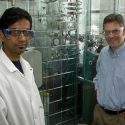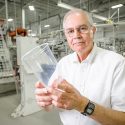UW-Madison part of DOE-funded ‘microgrid’ collaboration
University of Wisconsin–Madison engineers will collaborate with industrial and government partners on a $14 million project to implement a microgrid power backup system at the nation’s fifth-largest incarceration facility — the Santa Rita Jail.
The collaboration is among nine U.S. Department of Energy-funded projects to share in up to $50 million to increase the efficiency and reliability of the nation’s electricity grid. At UW–Madison, Grainger Professor of Power Electronics and Electrical Machines Thomas Jahns and Professor Emeritus of Electrical and Computer Engineering Robert Lasseter will provide technical input for implementing Lasseter’s microgrid concept at the jail.
The microgrid technology, as demonstrated at the jail, also could apply to other facilities, businesses, or even residential neighborhoods, and has the potential to make blackouts a thing of the past.
The Santa Rita Jail has a fuel cell and a solar panel, but both need voltage support from the utility to operate. If the voltage from the grid drops, the fuel cell shuts down and takes hours to get back online after the utility is restored. The jail has a backup system: two generators. However, the generators take too long to power up, forcing the fuel cell and solar panel to shut down.
The research team will implement a microgrid at the jail in hopes of preventing such shut-downs. A microgrid is a control technology that allows a power consumer to switch between utility-connected and independent operation. All parts of the system work together autonomously to keep the jail fully powered.
"But to make them all work properly together, we’ll have to work to modify the generator and storage controls so that they can work as a coordinated system," says Lasseter.
During a utility grid disturbance, a "smart switch" will isolate, or island, the jail’s microgrid from the utility and trigger the backup systems, including an added energy storage system called a flow battery. The autonomous controls will pull power from the flow battery while the generators power up, so there will be no disruption to power within the jail, and the fuel cell and solar panel can keep operating normally. Then, when the utility grid returns to normal, the system automatically resynchronizes and reconnects itself to the grid in an equally seamless fashion.
"If we go into the utility distribution system and start providing them the ability to island with generation, then we can radically change the way our distribution systems work and we can bring a lot higher reliability at the customer level," says Lasseter.
Partners in the project include Chevron Energy Solutions, Alameda County, Pacific Gas & Energy, VRB Power Systems, SatCon Technology Corporation, the National Renewable Energy Laboratory, Lawrence Berkeley National Laboratory, and Energy and Environmental Economics.
Tags: business, energy, engineering, research



